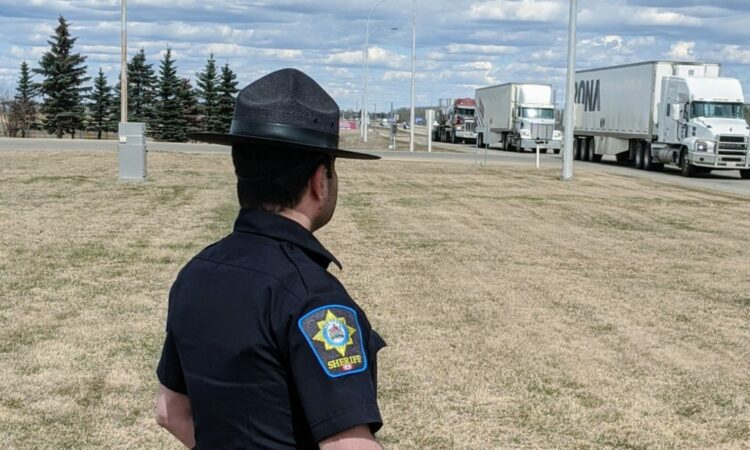Western Canada’s highway enforcement teams are increasingly targeting their inspection activities, using tools as diverse as new technologies, social media, and the simple power of observation.
Look no further than the out-of-service rates in Alberta for proof that a focus exists. The province’s teams conducted 147,000 inspections between January 2016 and September 2021, placing a steep 42% of the equipment out of service. Another 24% needed extra attention.
“Those numbers aren’t just random inspections. They come from us doing our job day in and day out,” said Alberta Sheriffs Highway Patrol District Sergeant Brian Davyduke, during a Dec. 7 webinar hosted by the Alberta Motor Transport Association, PSAC, and Energy Safety Canada. “That’s with trained officers on the side of the road doing these inspections and identifying vehicles that require inspection.”
In B.C., meanwhile, Focused Inspection Teams will on some days target specific components already known to generate high out-of-service rates.
“The items are higher when you check them,” said Richard Roberts, deputy director of the B.C. Commercial Vehicle Safety and Enforcement Branch.
It can also explain why issues like cargo securement and lighting rank among some of the top recurring issues. Dark bulbs can be spotted at a glance. “It’s something you can pick off right away,” agreed Sgt. Kyle Watson of Manitoba Carrier Enforcement.
“If we get those types of indicators, those are the vehicles we’re going to want to concentrate on.”
– Brian Davyduke
The same can be said for the number of load securement devices on a flatbed trailer. If there are missing tiedowns, there’s a good chance that the vehicle wasn’t properly inspected before beginning its journey, Davyduke said.
Things can still happen on route, he agreed. “That doesn’t change the result of the inspection.”
Technology is supporting the growing focus. Alberta teams, for example, have added thermal imaging tools to their arsenal, helping to detect anomalies like a single axle that is not as warm as the others.
“It doesn’t catch everything, but it’s very interesting,” Davyduke said. “If we get those types of indicators, those are the vehicles we’re going to want to concentrate on.”
In one case alone, the tools helped to spot a stream of dangerous goods leaking from a tanker, he said.
A new generation of tools is also looking beyond trucks and trailers alone.
Saskatchewan officers, for example, are now equipped with roadside cannabis detectors, and in the first 10 months of this year had issued 20 administrative charges for drugs involving drivers of commercial vehicles. There were no such charges last year.
A Saskatchewan Highway Patrol officer was also responsible for Canada’s largest-ever cannabis seizure involving a commercial vehicle, said Acting Sgt. Mathew Austin. That April 7 traffic stop netted 4,000 lb. of marijuana.
Inspection technology
A coming generation of technology could even allow for more inspections to be completed without requiring a truck to stop.
Level 8 inspections – essentially a digital Level 3 inspection that can be completed while a truck continues to move – are being developed, said Kerri Wirachowsky, the Commercial Vehicle Safety Alliance’s director – roadside inspection program. “It’s just not there yet.”
One of the last hurdles will involve finding a way to share driver information about Hours of Service and licence status.
“There’s a lot of Freedom of Information issues that go on between the state and third party,” she explained.
“I think you’ll see it very soon.”
Electronic logging devices (ELDs) will play their own role in out-of-service rates once mandates are enforced.
“The thing with ELDs is the rules are still the same,” Davyduke stressed. “Really, all we’re dealing with is the use of a different technology to document those hours.” But there will likely be challenges as drivers learn how to use the devices, he said.
“Ensure that you are meeting the requirements. There are requirements for instructions that need to be in a vehicle.”
Even social media feeds are helping to target enforcement efforts. B.C. teams are monitoring posted videos that are posted online, Roberts said, referring to filmed examples of dangerous driving.
“We do our best to follow up on a lot of that.”
Maximizing resources
The targeted inspections all help to maximize available resources, and there are clearly limits to the numbers that are available. Some open jobs for inspectors, just like truck drivers, remain unfilled.
The number of Alberta inspectors has been dropping in recent years and some vacancies remain open, Davyduke said, noting that more officers will be hired. “We really need to focus the vehicles that we’re inspecting.”
In the meantime, officers in B.C. are doing what they can to keep essential traffic moving in the midst of massive flooding in the province.
“We’re heavily focusing on those highways to keep them open,” Roberts said. “Inspections are still happening. We are heavily enforcing moving violations and things like that.
“Do what you can to keep the speeds down and drive safely out there.”


